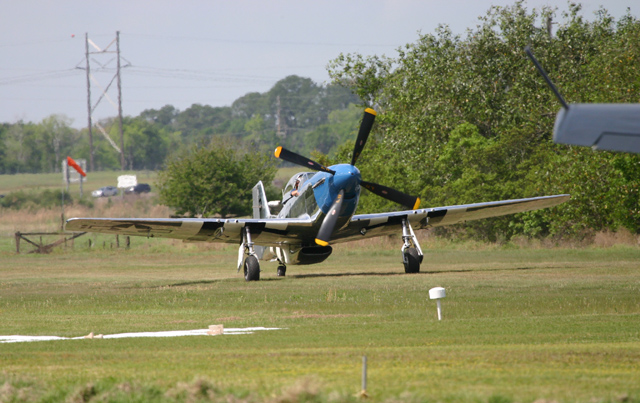
1945 North American P-51D Mustang
The first Mustangs were designed for the British before the U.S. entered WW II and were powered with the American Allison engine. Called the Apache by the Americans, it was the British who named the aircraft Mustang. And because they were the first to use it in combat, that name stuck. While it was a great aircraft at low altitudes, the Allison could not compete with the British Rolls-Royce Merlin-powered Spitfires at altitude because of the Merlin’s more advanced supercharger technology. Merlin-powered Mustangs were tried, and a great fighter was born. Early Merlin-powered Mustangs had the “high-back” fuselage and four .50 caliber machine guns. This D model Mustang came out late in the war with the “bubble” canopy for improved visibility and six .50 caliber machine guns.
The Mustang’s ability to carry large external fuel tanks and the Merlin’s good fuel economy gave the air war in Europe a different look. With over 450 gallons of fuel, the Mustangs now had a range of over 2000 miles and the capability to escort the long range bombers on their entire missions.
This aircraft is painted in the colors of the highest scoring Mustang ace, Major George Preddy, who became famous after one mission where he claimed six kills! Preddy lost his life on Christmas Day of 1944 flying a mission during the Battle of the Bulge while chasing a German Focke Wulf 190 at treetop level. Reports of two enemy aircraft were forwarded to American troops in the vicinity, and Preddy was shot down by friendly fire.
On display courtesy of the World’s Greatest Aircraft Collection
Specifications
- Year Built — 1945
- Wingspan — 37′
- Cruise Speed — 300 mph
- Top Speed — 434 mph
- Gross Weight — 11,000 lbs
- Engine — Packard build Rolls Royce Merlin 1650 (1,500 hp)
- Armament — Six.50 caliber Browning machine guns. Two 500 lb. bombs on under-wing racks
Kermit’s Comments
To own a P-51 had always been a dream of mine. My first vintage aircraft was an AT-6 trainer and was acquired for the sole purpose of training in the same type of aircraft the fighter pilots of WWII had done. After six months of flying the AT-6, this P-51 came on the market and was purchased in 1979 for $155,000. One of the most memorable days of my life was taxiing the P-51 onto a ramp full of friends when I was only 25 years old! It was at that point in my life I realized my love for vintage aircraft. Soon after I opened Weeks Air Museum in Miami and began to collect even more aircraft.